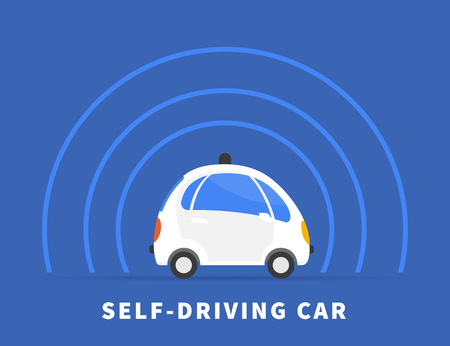Cars of the Future Closer Than We Think

51292592 – self-driving car flat illustration on blue background. conceptual symbol of intelligent controlled driverless car with sensors
March 9, 2017
Are self-driving cars the cars of the future? Are self-driving cars really the safest cars on the road? Do their pros outweigh their cons? The technology for these cars is constantly improving and may even be the cultural norm in the not-so-distant future.
Currently, Google, Audi, BMW and Hyundai are the leading companies in the development of completely autonomous cars, while Tesla is working on an auto-pilot mode for some of its newer models.
At the moment, Tesla’s auto-pilot is the first major step toward complete autonomous driving the world has seen. According to their website, the car uses four to eight different sensors, ranging from front-, back-, and side-mounted cameras, to ultrasonic sensors and radars. The varying sensors give the car a 360-degree view of everything around it and can even tell if objects within a close proximity are hard or soft, as well as can even see through them, giving the car a view better than any human driver could achieve. Most of the other self-driving cars utilize the same technology, with slight variations here and there, such as Google’s use of a live satellite feed to help the car position itself.
The use of this newfound technology can greatly improve today’s driving environment. Due to the lack of human input required for these cars to operate, it greatly benefits the surrounding environment. According to the Auto Insurance Center, 81 percent of all traffic accidents are the result of driver error. The cars not only make the driving environment safer, but they can also improve overall ride enjoyability. With the driver of the car no longer having to man the car, they can spend their time reading, catching up on work, talking to the other passengers, or even enjoy a movie.
According to lifehack.org, autonomous vehicles are optimal for big cities. The cars are able to drive within a close proximity to each other at a slower speed, making the ride a lot smoother, thus reducing congestion. The car can also reduce parking issues and improve traffic flow by dropping the passengers off at their destination and then finding a parking space, even if it is a bit far, because the car can be summoned to the driver with the touch of a button.
But there are a lot of potential drawbacks of this technology. The car’s use of GPS and other apps, such as your calendar, allow the onboard computer to know where the car is at all times and can even record frequently visited locations. This invasion of privacy can allow companies to track you and may even make it susceptible to hacking, which can lead to accidents.
Another drawback is that the technology is expensive, and at least at first, the only people who will be seen in these cars are the wealthy.
There are a few instances where human instinct is more ethical than the car’s operating system, but they are still important. In the event that an autonomous car is in a compromising situation, does the car prioritize the safety of the passengers or the safety of everyone around them? In a video by TED-Ed, a situation is presented where a heavy object falls off a truck in front of an autonomous car and there is a motorcyclist on the left and an SUV on the right. Does the car a) hit the object head-on, jeopardizing the life of the passenger, but keeping everyone around safe? b) swerve to the left, hitting the motorcyclist, but saving the life of the passenger? or c) swerve to the right, hitting the SUV because it has a better likelihood of its passengers surviving?
If it were a human driving the car, no matter which option were chosen, it would be the right one, as it would be based on human instinct. If it were an autonomous car making the decision, it could be classified as premeditated homicide, depending on the outcome, as stated in the TED-Ed video. As the computer uses an algorithm to make a decision, thus the outcome may be determined months before the actual accident.
The use of self-driving cars will only become more successful, the more they are used, as stated by the Auto Insurance Center, “Self-driving cars may be a part of the future, but if they are successfully deployed across America’s roadways, it will be a revolution not just for drivers and traffic patterns, but also for the transportation industry as a whole.”

